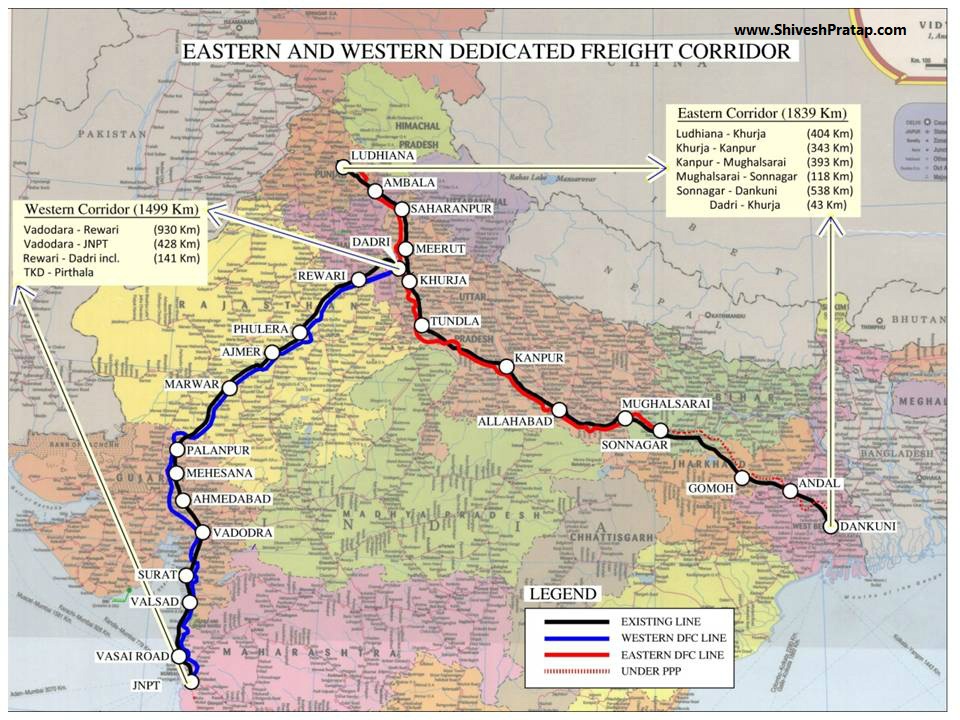Narendra Modi is keeping an eye on DFC projects and assigned this single task to Manoj Sinha Minister of State for Railways. This Rs 81,459 cr worth ‘Dedicated Freight Corridor’ project to be completed by 2019 and it will become a feather in Modi’s cap.
“Prevailing scenario in goods transportation is not very good and everybody wants faster movement. Railways is constructing separate corridors for freight to speed up transportation and it will be completed in time,” Minister of State for Railways Manoj Sinha.
Railways is constructing Eastern Corridor from Ludhiana to Dankuni (1840 kms) and the Western Corridor from Dadri to Jawaharlal Nehru Port (1502 kms).
The entire Western Corridor is being funded by Japan International Cooperation Agency (JICA), while the Eastern Corridor from Mughalsarai to Ludhiana is being funded by the World Bank
Unique features and benefits of Dedicated Freight corridors:

- World’s first and only double-stack, international standard container freight trains run using electric locomotives, which are superior in terms of environment and economics. DFC uses the panto-graph which holds world record for their height, as India is the only country to have double-stack trains on electric locomotives, which can transport international standard containers. Once implemented DFC will make Indian freight transport cheapest in the world as they run on a Broad-gauge with double-stack using electric locomotives, which no other country has achieved.
- World’s first and only triple-stack container trains will run on these lines. Broad-gauge DFC allows triple-stack container to be used in these railway lines for domestic traffic. This could be implemented in the domestic sector movements only, as, for international trade, there are standard container sizes. This will reduce the unit cost of transportation by permitting higher volumes of relatively lightweight and high value cargo in each rake. These containers would be well suited for moving voluminous and high value cargo such as cars, automobile parts, electronics and electrical components, ready made garments, tea, medicinal items, spices, plastic goods, jute, leather goods, de-oiled cakes and paper. A first in the world, as India uses Broad-gauge electrical locomotives for freight movement with triple-stack configuration.
- One of the best axle-load in the world, though railway engineers and India may not write their name in the history books as Australian private railway line holds the record for Heaviest haul railway in the world. Dedicated Freight corridors will have higher axle load of 32.5-tons/axle.
Axle load for DFC loading is 32.5t. following combinations are proposed for dfc loading.
1. 6 axle loco (single loco) of 32.5t axle load+ 32.5t axle load (4axle) Gondola wagon
2. Double loco of 32.5 t axle load + wagon 32.5t axle load
3. Six axle 30t loco (Double)+ wagon 32.5t
4. Eight axle loco + wagon
- Currently goods trains are moving at 25/26 km per hour speed. The speed will go up to 100 km per hour on the DFC which will be beneficial for the industry.
- Indian freight movement will move away from inflationary diesel fuel to the indigenous electrical power, helping India to control its Current Account Deficit. India, of late has become one of world leader in electricity generation by renewable sources. India will not be dependent on foreign countries for its freight railway network’s energy needs.
- Freight Trains with length 1.5 km, width 4660 mm, height 7.1 m, load 15,000 Ton in a double-stack configuration will run on these lines. These are the minimum configuration for which railway line will be built, but operational expertise and efficiency is expected increase the capacity in most of above parameters.
- India will move away from single-stack freight trains to double-stack configuration.
- Technology used for the double-stack electrical locomotive will be used in passenger trains to introduce double-decker passenger electrical trains, which will result in lower ticket prices.
- UBS, has identified DFC as one of the project which will have effects felt on Indian economy for foreseeable future.
- DFC using electric locomotive has major environmental benefits. World Bank study has shown that DFC will reduce Green House Gas emission and will have positive effect on reducing the pollution.
- Passenger trains can run faster and India can achieve its target of running sub-high speed trains on the current tracks. Freight traffic will migrate to the new network, freeing up the current trunk lines for passenger traffic.
- India will have speed of freight trains up to 100 km/hour, from the current average freight train speed of 20–30 km/h. It may be increased to 120 km/h achieved by the Chinese freight trains, to boost India’s cargo capacity by 12 percent.